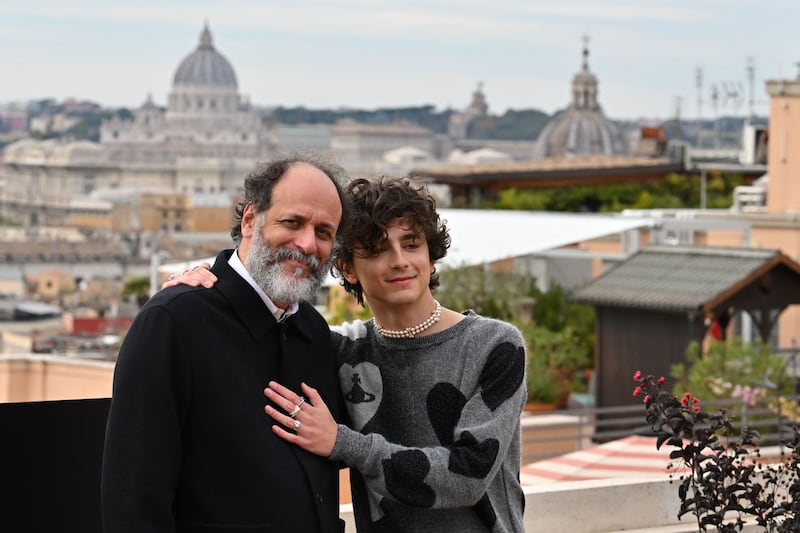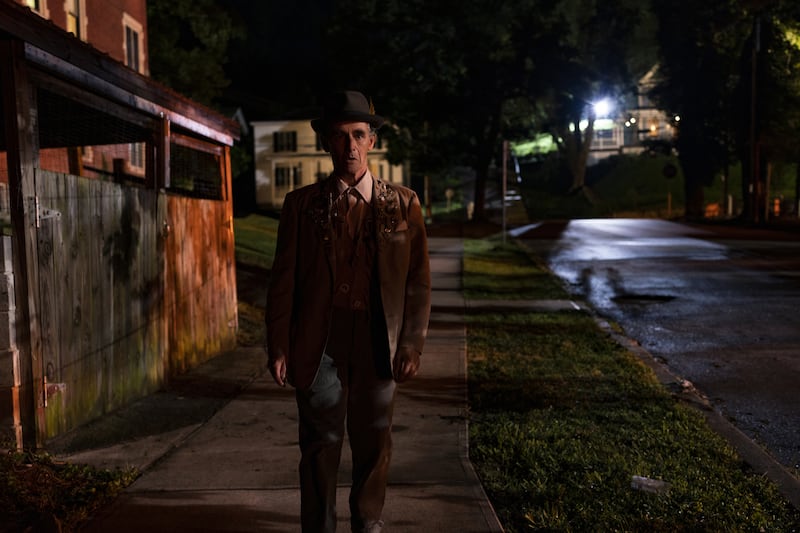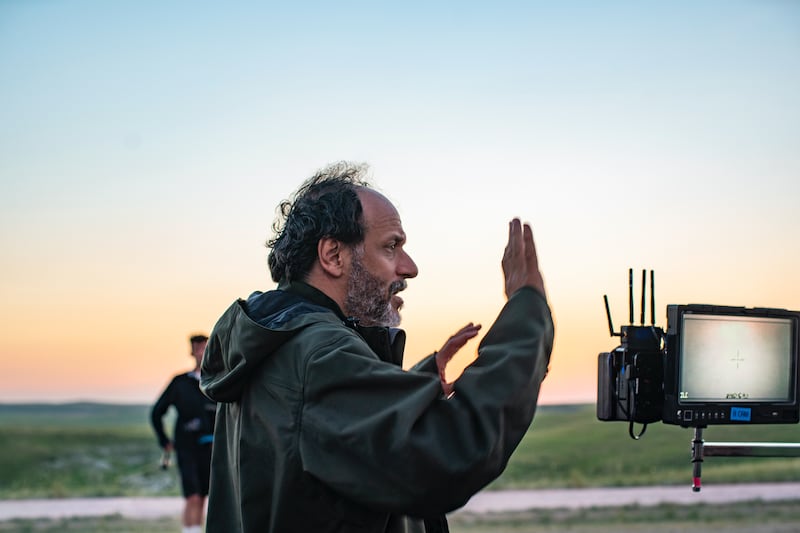In the past two years, Luca Guadagnino has unveiled the coming-of-age drama We Are Who We Are for HBO; a music video for Sufjan Stevens; the short smartphone-shot lockdown film Fiori, Fiori, Fiori; a commercial for the lux footwear house Ferragamo; and a feature-length documentary, Salvatore: Shoemaker of Dreams. By the time the Italian’s romantic cannibal movie, Bones and All, premiered at the Venice Film Festival, he had already completed work on Challengers, a tennis romcom starring Zendaya and Josh O’Connor scheduled for release in August 2023. Next up is an Audrey Hepburn biopic starring Rooney Mara.
And then there’s his day job. In 2017, he founded Studio Luca Guadagnino, the interior-architecture practice.
When exactly does he sleep?
“I sleep five hours a night, but I should go to seven,” he smiles. “I’m a workaholic person. I should change my attitude in order to rest a little bit. Honestly, it’s very difficult for me to lie down because the people I work with are an amazing team of people. They know that I work a lot and so they keep making me work because they work too.”
Eleanor O'Dwyer: My friends tell me to stop discussing religion on first and second dates
How to stage an Irish music festival: From All Together Now to Beyond the Pale
Picture story: Druid Theatre prepares to mark 50 years with Shakespeare and Synge
Why restraining yourself at the garden centre will lead to a more beautiful garden
As a young boy in Palermo, he asked his mother to buy him a Super 8 camera so that he might submerge a piece of cow meat in a glass of water and film its decomposition. The shoot was abandoned due to the revolting smell
He’s not exaggerating. Guadagnino is all about the collective experience. He recently “bridged” his two professions by enlisting Stefano Baisi, a fellow architect, as a production designer. The director has worked repeatedly with actors Walter Fasano, Marco Morabito, Tilda Swinton and Dakota Johnson. Cinematographers Sayombhu Mukdeeprom and Yorick Le Saux have shot three films a piece for the filmmaker; Bones and All brings back Guadagnino veterans Michael Stuhlbarg, Jessica Harper, and Chloë Sevigny.
He dreamily recalls a backstage tour of an opera house in Buenos Aires, an experience that he likens to The Red Shoes, one of his favourite films.
“Every time I go to the theatre – particularly when I visit backstage – when the director of the theatre is gracious enough to show me backstage, I have a very beautiful moment,” says Guadagnino. “Because I love that sense of community and craft and everybody working together at the same time, towards the same goal. So I love the idea of building a community of artists working together in this theatrical sense.”
Bones and All also reunites the director with Timothée Chalamet, an actor who was catapulted to fame after his 2017 performance in Guadagnino’s heated love story, Call Me By Your Name. The 26-year-old actor has subsequently been nominated for two Academy Awards and has attracted an army of Chalamaniacs. Thousands of them camped out on the Lido in advance of the premiere of Bones and All.
‘Immense talent’
“Every actor is acting with the baggage of their experience of life and their understanding of human nature,” says the filmmaker. “The more they grow up, the more they grow and the more they refine their talent, which was already immense in the case of Timothée Chalamet. I can tell you that from being a boy to becoming a young man, he is able to bring more and more thoughtfulness to the way in which he is able to understand human nature.”

Bones and All is adapted from a YA novel by Camille DeAngelis. The film opens in the 1980s with nervous, unfashionable teen Maren (Waves’ Taylor Russell) sneaking out to a sleepover, unbeknown to her zealously overprotective father. One shocking scene later and her dad’s concerns are entirely justified: Maren has a craving for human flesh, an appetite that sees her embark on a road trip in search of her long lost mother.
Along the way, she meets fellow anthropophagite Sully (Mark Rylance channelling Night of the Hunter to terrifying effect) and falls for Lee (Chalamet). It’s puppy love but with gore and crunching noises. At least one patron at the Venice premiere required medical attention. It’s a long-cherished goal for the director, who remade Dario Argento’s Suspiria in 2017 and, who, as a young boy in Palermo, asked his mother to buy him a Super 8 camera so that he might submerge a piece of cow meat in a glass of water and film its decomposition over time. The shoot was abandoned due to the revolting smell.
“I heard about people fainting and some people also throwing up, some screaming,” says Guadagnino. “Of course, in a way, I am delighted because if a movie, if any movie moved somebody to that degree, then the movie has something to say, somehow, or has hit a chord. But at the same time, I hope that the element comes from the discomfort of dealing with the depth of what these characters go through and not with the shock value of it.”
‘I couldn’t relate to them and understand them regarding cannibalism. The goal is to find a way to use the literal for a metaphor’
Here’s a discombobulating phrase: cannibalism is having a moment. Last July, Soylent Green began trending across social media platforms after the New York Times published an article titled, A Taste for Cannibalism?, citing such popular people-eating themed works as Raw, Fresh, Santa Clarita Diet, and Yellowjackets. Guadagnino, thankfully, was more interested in the metaphorical aspects of the taboo eating plan.
“I was more interested in the actual inevitability of their nature than the actual nature,” says Guadagnino. “I was interested in something they cannot control and that they won’t control. When I start with the script, I said to myself, I think you can tell the story of these characters because I understand their sense of solitude. I couldn’t relate to them and understand them regarding cannibalism. The goal is to find a way to use the literal for a metaphor, but without ruining the movie, with the thematics and metaphorical aspects, so that becomes too intellectual.”
Bones and All is the filmmaker’s first project to be set and shot in the United States. It falls into that most American of genres, the road movie, with locations in Chillicothe, Ohio, and Cincinnati. In preparation, he studied photographer William Eggleston’s 1960s portraits of the Deep South.

‘Codes of cinema’
“Eggleston was my guideline,” he says. “He was a great American artist, and he was paramount for me for my DP [director of photography] and for my production designer. The beautiful, personal subjectivity that he brings to the way in which you see America, from a perspective that was not the main one. I love the codes of cinema. And the road movie is somehow like the DNA of what cinema means in America. Even the westerns are road movies, right?
“I try to make the movie in sequence. We put ourselves at the centre of the tri-state in Cincinnati. And then, from there onward, moved from Ohio to Kentucky. Indiana, Maryland, all the way to Nebraska and finding locations that were perfect for the period and using them.”
At first glance, Bones and All and Guadignino’s recent work feels more youthful than the grown-up drama of A Bigger Splash. But even his adult-oriented movies are dominated by something like puppy love. The romance between Russell and Chalamet’s characters is no less fevered than watching Tilda Swinton pegging it across the screen, against all better judgment, to be with her younger paramour in I Am Love.
“Before I made this, I broke up with my partner of 11 years and I was desolate,” says Guadagnino. “Somebody said, I understand you. I understand your films. You are such a romantic person. But what is interesting is that being a romantic person is not a positive value per se. It may be a curse.”
‘Cinema knows no geography, no boundaries. Look at Billy Wilder, one of the greatest Hollywood directors. What was his sensibility? German? European? American?’
Guadagnino was born in 1971 to a Sicilian father and an Algerian mother. He spent his early childhood in Ethiopia, where his father lectured in Italian literature. The family returned to Palermo following the outbreak of civil war.
“I like to think that I’m a citizen of the world, as Truman Capote said,” says the filmmaker. “Cinema knows no geography, no boundaries. Look at Billy Wilder, one of the greatest Hollywood directors. What was his sensibility? German? European? American? The cinema that I love is transactional, without nationality.”

The director’s first feature, The Protagonists, established an ongoing collaboration with Tilda Swinton and premiered at Venice, the same festival where he recently won the Silver Lion for Bones and All. It continues to be a learning curve, he says, but it’s easier than it was in the early days of his career.
“I think my first movie was difficult, for sure,” he recalls. “I learnt that it wasn’t important to know exactly what you wanted because then you couldn’t accept what others were bringing to the table. And my second movie Melissa P was made with a studio, a local production from Sony in Europe. And I had the bitter lesson of having the film taken from me. I’ve learned how to avoid that. I do not allow anybody else to take control of my projects.”
Bones and All opens on Wednesday, November 23rd















